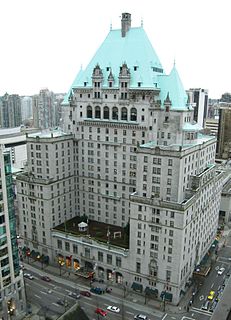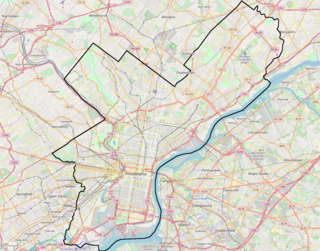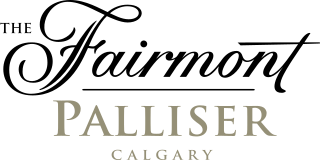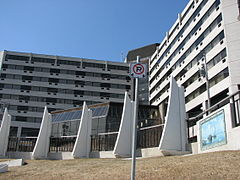
St. John's is the capital and largest city of the Canadian province of Newfoundland and Labrador. It is on the eastern tip of the Avalon Peninsula on the large Canadian island Newfoundland. The city spans 446.04 square kilometres (172.22 sq mi) and is the easternmost city in North America.

Memorial University of Newfoundland and Labrador, also known as Memorial University or MUNL, is a public university based in St. John's, Newfoundland and Labrador, with several satellite campuses in Canada and England. Memorial University offers certificate, diploma, undergraduate, graduate, and post-graduate programmes, as well as online courses and degrees. Memorial's campuses include St. John's, Corner Brook, Happy Valley-Goose Bay, and Harlow.

The Fairmont Hotel Vancouver, formerly and still informally called the Hotel Vancouver, is a historic hotel in Vancouver, British Columbia. Located along West Georgia Street the hotel is situated within the city's Financial District, in Downtown Vancouver. The hotel was designed by two architects, John Smith Archibald, and John Schofield. The hotel is currently managed by Fairmont Hotels and Resorts.

The Fairmont Château Laurier is a 660,000-square-foot (61,000 m2) hotel with 429 guest rooms in the downtown core of Ottawa, Ontario, Canada, located near the intersection of Rideau Street and Sussex Drive and designed in a French Gothic Revival Châteauesque style to complement the adjacent Parliament buildings. The hotel is above the Colonel By Valley, home of the Ottawa Locks of the Rideau Canal, and overlooks the Ottawa River. The main dining room overlooks Major's Hill Park. The reception rooms include the Wedgewood-blue Adam Room; the Laurier Room defined by Roman columns; the Empire-style ballroom and the Drawing Room featuring cream and gold plaster ornament. The hotel was designated a national historic site in 1980.

The Fairmont Royal York, formerly and still commonly known as the Royal York, is a large historic luxury hotel in Toronto, Ontario, Canada. Located along Front Street West, the hotel is situated at the southern end of the Financial District, in Downtown Toronto. The Royal York was designed by Ross and Macdonald, in association with Sproatt and Rolph, and built by the Canadian Pacific Railway company. The hotel is presently managed by Fairmont Hotels and Resorts.

Fairmont The Queen Elizabeth is an historic grand hotel in Montreal, Quebec, Canada. With 950 rooms and 21 floors it is the largest hotel in the province of Quebec, and the second largest Fairmont hotel in Canada after the Fairmont Royal York in Toronto, which has 1365 rooms. Located at 900 René Lévesque Boulevard West, in the heart of Downtown Montreal, it is connected to Central Station and to the underground city. The hotel is well known for being the location for John Lennon and Yoko Ono recording "Give Peace a Chance" in Room 1742 during their anti-war Bed-In.

The Fairmont Banff Springs, formerly and commonly known as the Banff Springs Hotel, is a historic hotel located in Banff, Alberta, Canada. The entire town including the hotel, is situated in Banff National Park, a national park managed by Parks Canada. The hotel overlooks a valley towards Mount Rundle, both of which are situated within the Rocky Mountain mountain range. The hotel is located at an altitude of 1,414 metres (4,639 ft).

The Fairmont Hotel Macdonald, formerly and commonly known as the Hotel Macdonald, is a large historic luxury hotel in Edmonton, Alberta, Canada. Located along 100 Street NW, south of Jasper Avenue, the hotel is situated in the eastern end of downtown Edmonton, and overlooks the North Saskatchewan River. The 47.7 metres (156 ft) hotel building was designed by Ross and MacFarlene and contains eleven floors. The hotel is presently managed by Fairmont Hotels and Resorts.

The Peace Hotel is a hotel on The Bund in Shanghai, China, which overlooks the surrounding areas. The hotel has two different buildings. The Sassoon House, originally housed the Cathay Hotel and is today the Fairmont Peace Hotel run by Fairmont Hotels and Resorts of Canada. The South Building was built as the Palace Hotel and is today a residence and studio for artists, known as The Swatch Art Peace Hotel. The two buildings both face the Bund, but are divided by Nanjing Road.

The Bellevue-Stratford Hotel is a landmark building at 200 S. Broad Street at the corner of Walnut Street in Center City, Philadelphia, Pennsylvania, United States. Constructed in 1904 and expanded to its present size in 1912, it has continued as a well-known institution for more than a century and is still widely known by that original, historic name. In 1988, the building was converted to a mixed-use development. It has been known since then as The Bellevue. The hotel portion is currently managed by Hyatt as The Bellevue Hotel.

The Fairmont Palliser, formerly known as the Palliser Hotel, is a hotel of the Canada-based Fairmont Hotels and Resorts chain. The historic hotel (1914) is located in downtown Calgary, Alberta at 133 9th Avenue SW adjacent to the Calgary Tower and Palliser Square. The Palliser is one of Calgary's oldest and most luxurious hotels.

The Rooms is a cultural facility in St. John's, Newfoundland and Labrador, Canada. The facility opened in 2005 and houses the Art Gallery of Newfoundland and Labrador, the Provincial Archives of Newfoundland and Labrador and the Provincial Museum of Newfoundland and Labrador.
The Broadcasting Corporation of Newfoundland (BCN) was the government-owned public radio service of the dominion of Newfoundland. Following Newfoundland's admission as a Canadian province in 1949, the BCN was absorbed into the Canadian Broadcasting Corporation, and its three main AM radio transmitters remain in operation today as CBC Radio One stations.

The Omni King Edward Hotel is a historic luxury hotel in Downtown Toronto, Ontario, Canada. The hotel is located at 37 King Street East, and it occupies the entire block bounded by King Street on the north, Victoria Street on the east, Colborne Street on the south and Leader Lane on the west.
Canadian National Hotels was a hotel chain under control by Canadian National Railways. In addition to their own hotels, it acquired some from predecessor railway companies like the Grand Trunk Pacific Railway, Grand Trunk Railway and Ottawa, Arnprior and Parry Sound Railway. Some of their assets were later acquired by rival Canadian Pacific Hotels after 1988.

Hotels in Toronto have been some of the most prominent buildings in the city and the hotel industry is one of the city's most important. The Greater Toronto Area has 183 hotels with a total of almost 36,000 rooms. In 2010, there were 8.9 million room nights sold. Toronto is a popular tourist destination, with it having the 6th highest room occupancy rate in North America, but about two thirds of rooms are taken by commercial, government, or convention travellers.

Downtown St. John's is the historic core, and central business district of St. John's, Newfoundland and Labrador, Canada. Located north of St. John's harbour, it is the business, entertainment, and tourism centre with office buildings, hotels, restaurants, and other services.

O'Reilly House is located in Placentia, Newfoundland and Labrador, Canada. It was built for Magistrate William O'Reilly who served as Magistrate of Placentia from 1897-1923. He was the son of Thomas O'Reilly who had been the magistrate of Placentia from 1877-97. In 1902, Magistrate O’Reilly employed the architect W.J. Ellis to build a Balustrade Queen Anne Victorian house that would serve as his family home.



















